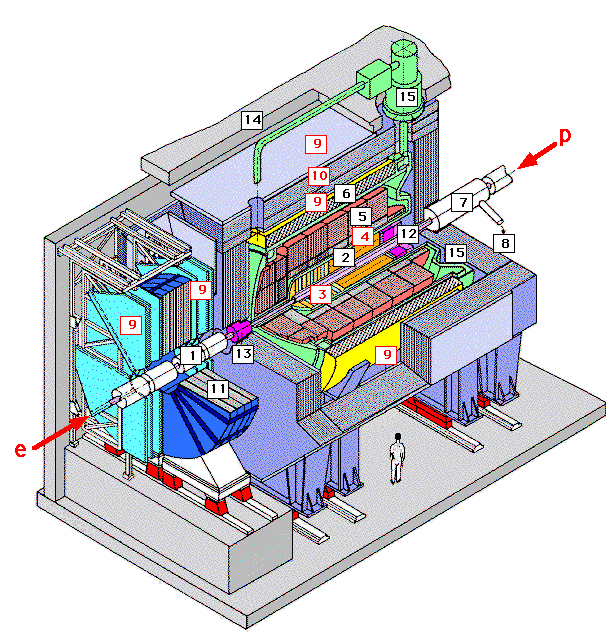All pictures and symbols are clickable !



start
back
forward
The H1 Detector
click to the red numbers...

- Beam pipe and beam magnets
- Central tracking chambers
- Forward tracking and Transition radiators
- Electromagnetic Calorimeter (lead, liquidargon)
- Hadronic Calorimeter (stainess steel)
- Superconducting coil (1,2T)
- Compensating magnet
- Helium cryogenics
- Muon cambers
- Return yoke (instrumented iron with streamer tubes
- Myon-Toroid-Magnet
- Warm calorimeter (Spacal)
- Plug calorimeter
- Concrete screen
- Liquid Argon cryostat.
Hera is a unique facility in the world where electrons and protons
are
accelerated to the highest collision energies ever attained. HERA
consists of
two storage rings, one for protons of 820 GeV and one for electrons
(or
positrons) of 30 GeV. The two beams circulate in opposite directions
in an
underground tunnel, 6.3km in length. At two interaction points the
particle
beams are directed against each other and collisions between
protons end
electrons take place. The reaction products are measured by large
detectors
like H1.
H1 is a collaboration of about 400 scientists of 39 institues from 12 countries
throughout the world. A large particle detector has been
constructed by H1 in the Hall North of the HERA accelerator, for
studying collisions between electrons and protons . The internal
structure of the proton is being investigated with unprecedent
accuracy by this detector, which is also suitable for searching
for hitherto unobserved particles. The unique experiment will
lead to a better understanding of the various particles that
make up our world and the interactive forces between them.
The picture shows the H1-detector being moved into its final
position at HERA in February 1992.
 Detector.gif (97K)
Detector.gif (97K)
H1 was designed to detect and measure the energetic particles
and jets emitted in the reactions taking place in collisions
between electrons and protons at HERA. Special emphasis was
placed on the identification of these particles, especially
electrons and muons. The fact that the protons enter the
interaction zone with much higher energy than the electrons was
also taken into account.
The design and construction of the calorimeter was one of the
most challenging tasks for the scientists and engineers in H1.
The determination of the jet energy is performed by reliable and
stable techniques using liquid argon ionisation chambers. The
interaction zone is surrounded by the calorimeter so that
practically no particles can escape undetected. In addition it
is divided into very small cells so that the jets can be very
well localised in space.
The tracks of charged particles are measured in various kinds of
wire chambers. Points along the the track can be measured with
an accuracy of about a thenth of a millimeter and in this way
the curvature of the tracks in the magnetic field can be
determined, thus allowing the momentum of the particles to be
calculated.
The data flow resulting from the interactions is prodigious and
after careful filtering and sorting using the most up-to-date
technique available at the present time, the resulting
information is stored on magnetic tape cartridges at the DESY
central main frame computer, for subsequent analysis.
The structure of the proton
This is the web version of an H1 leaflet (Status 3.96)
Translated to html by C.Preine (3.96)
Last updated 27.3.96 by JB



